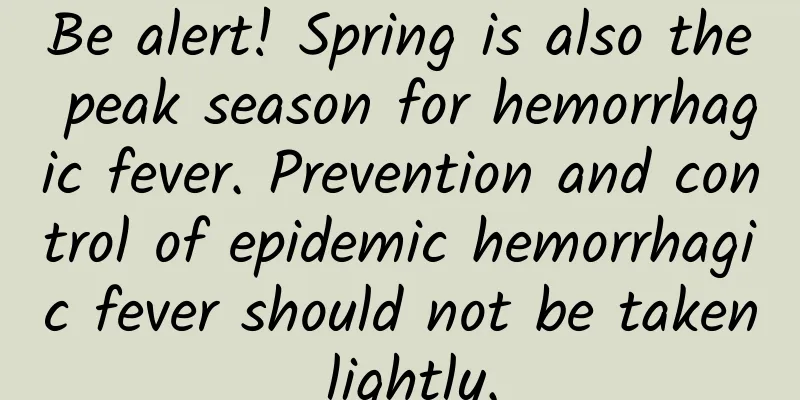Be alert! Spring is also the peak season for hemorrhagic fever. Prevention and control of epidemic hemorrhagic fever should not be taken lightly.

|
At the end of last year, the Chinese Center for Disease Control and Prevention held a "Video Conference on Epidemic Hemorrhagic Fever Prevention and Control in Key Provinces". Experts pointed out that epidemic hemorrhagic fever has two peak incidence periods in spring and autumn and winter in my country, and rodent control is the main prevention and control measure. So, how should we prevent and control hemorrhagic fever? Infectious diseases of the same level as COVID-19 Hemorrhagic fever, formally known as hemorrhagic fever with renal syndrome (HFRS), is a natural epidemic disease caused by Hantavirus, with rodents (Apodemus nigra and Rattus norvegicus) as the main source of infection. Hemorrhagic fever is a Class B infectious disease that is required to be reported in my country, and is at the same level as viral hepatitis, AIDS, COVID-19, SARS, etc. Hantavirus, also known as Hantan River virus, is a species of Bunyaviridae. Hantavirus is a single-stranded negative-sense RNA virus with a round or oval shape, a double-layer envelope, and fibrils on the outer membrane. Currently, there are two main types of Hantavirus that cause epidemic hemorrhagic fever in my country, namely the Hantavirus type (type I) carried by wild mice and the Seoul virus type (type II) carried by house mice. my country is one of the main epidemic areas of hemorrhagic fever. In the 1980s, the highest annual reported number of cases in my country exceeded 100,000. In recent years, the epidemic has declined significantly, but there are still periodic fluctuations. There are two peaks of incidence in spring and autumn and winter. Generally, the peak incidence in autumn and winter is much higher than that in spring. Be vigilant about these transmission routes 1. Respiratory transmission: Aerosols formed by dust contaminated by virus-carrying excrement of rodents, such as urine, feces, saliva, etc., can be transmitted through the respiratory tract and cause human infection. 2. Transmission through the digestive tract: Eating food contaminated by rodent excrement can cause infection through the oral cavity or gastrointestinal mucosa. 3. Contact transmission: Infection can also occur when rat bites and wounds come into contact with virus-carrying rat excrement or blood. 4. Vertical transmission: After a pregnant woman is infected with the disease, the virus can infect the fetus through the placenta. Don't treat it as a common cold The initial symptoms of hemorrhagic fever are similar to those of the common cold, including fever, body aches, loss of appetite, nausea and vomiting. Therefore, it is easy for people to mistake it for a common cold and think that it will be fine after two days of endurance. However, they do not know that this will delay the best time to treat hemorrhagic fever. So, how should we distinguish hemorrhagic fever from the common cold? 1. Most patients with epidemic hemorrhagic fever have a history of contact with rats; 2. After the fever of common cold patients subsides, their condition will be relieved, while the condition of hemorrhagic fever patients will worsen after the fever subsides, and they will have abnormal conditions such as low blood pressure, oliguria or polyuria; 3. Patients with epidemic hemorrhagic fever will have "drunk" facial features, such as redness of the face, neck and upper chest, conjunctival congestion (the three reds), headache, back pain, and orbital pain (the three pains); 4. Patients with the common cold will not bleed, but patients with hemorrhagic fever may have bleeding symptoms. Mild patients may have bleeding spots and ecchymosis on the skin, while severe patients may have nosebleeds, vomiting blood, bloody stools, etc. Three things to do to prevent To prevent epidemic hemorrhagic fever, individuals and families should mainly do the following three things: 1. Rat prevention and extermination are the key. Rat prevention is to cut off the transmission route, and extermination is to eliminate the source of infection. Prevent rats from entering the house; wear gloves when cleaning places contaminated by rat urine and feces; wear masks and gloves when cleaning unused sheds, warehouses or other buildings; wear rubber or plastic gloves when cleaning mousetraps and rat nests. 2. Maintain good food and personal hygiene to prevent rodent excrement from contaminating food, and do not touch rodents or their excrement with your hands; when doing animal experiments, be careful to avoid being bitten by large or small rats. 3. Patient treatment should be "three early and one close", which can significantly reduce the mortality rate. Early detection - suspected cases should be treated as soon as possible and reported to the disease control agency in a timely manner; early rest - stay in bed and rest immediately after the onset of the disease, and reduce activities; early treatment - after the symptoms of hemorrhagic fever are found, go to the nearest standardized medical institution for treatment immediately, and avoid long-distance transfers that may aggravate the condition. Vaccination is the most effective prevention After the founding of the People's Republic of China, my country began to study the cause of hemorrhagic fever. In the 1980s, my country put the research of hemorrhagic fever vaccine on the official agenda, and approved the first hemorrhagic fever vaccine in 1992. In 1997, the research results of hemorrhagic fever vaccine won the first prize of National Science and Technology Progress. In the following decades, my country's hemorrhagic fever vaccine has been improved many times. At present, the main application in China is the bivalent inactivated vaccine of hemorrhagic fever with renal syndrome, which is made by inoculating cells with type I and type II hemorrhagic fever with renal syndrome virus, culturing, harvesting virus liquid, inactivating virus, and adding aluminum hydroxide adjuvant. The cells used to culture type I and type II hemorrhagic fever with renal syndrome virus are primary cells of hamster kidney or gerbil kidney, and vera passage cells can also be used. The immunization schedule for hemorrhagic fever with renal syndrome vaccine is: one injection on day 0 and 14 as basic immunization, and one booster immunization 6 months later. It is suitable for adults aged 16 to 60. In 2007, the "Implementation Plan for Expanding the National Immunization Program" issued by the former Ministry of Health clearly stated that "hemorrhagic fever vaccines should be administered to key groups in key areas." Facts have proved that vaccination is the most effective way for individuals to prevent hemorrhagic fever. People aged 16 to 60 in high-incidence areas, especially farmers approaching 60 and students who have just turned 16, should actively go to local vaccination sites for full and standardized vaccination to protect their personal health. Anyone who goes to epidemic areas for outdoor exploration, tourism, farming and other activities, or before long-term outdoor work tasks, can be vaccinated with hemorrhagic fever vaccine to prevent infection. Author: Yaohuluwa Medical and Biological Science Popularization Group |
<<: What is the normal range of high blood pressure?
Recommend
Causes of lower abdominal pain after sex
Sexual intercourse is an indispensable behavior i...
Nursing measures for patients with esophageal cancer
In the long river of life, some journeys are dest...
What to do if you feel bad during early pregnancy
For women who are pregnant for the first time, wh...
Body aches three months after delivery
Three months after the mother, she will experienc...
7 foods to lock in youth and keep your face young
Health and longevity is a lifestyle habit and als...
What to do if your breasts are sagging and soft
Many mothers who have given birth will experience...
The most common site of tubal pregnancy
Generally speaking, if a woman has a fallopian tu...
Sensor Tower: Insights into the social application market in 2024
With the popularity of short videos and the itera...
Can I have sex during my menstrual period? Anything to note?
I believe that married women will face the questi...
Red spots on feet during pregnancy
After pregnancy, some red spots appear on the fee...
Pregnancy four-dimensional color Doppler son picture
In fact, color Doppler ultrasound examination for...
Will my breasts hurt after taking birth control pills?
Normally, breast pain will not occur after taking...
Pros and cons of natural birth and caesarean section
When a woman is giving birth, there are generally...









